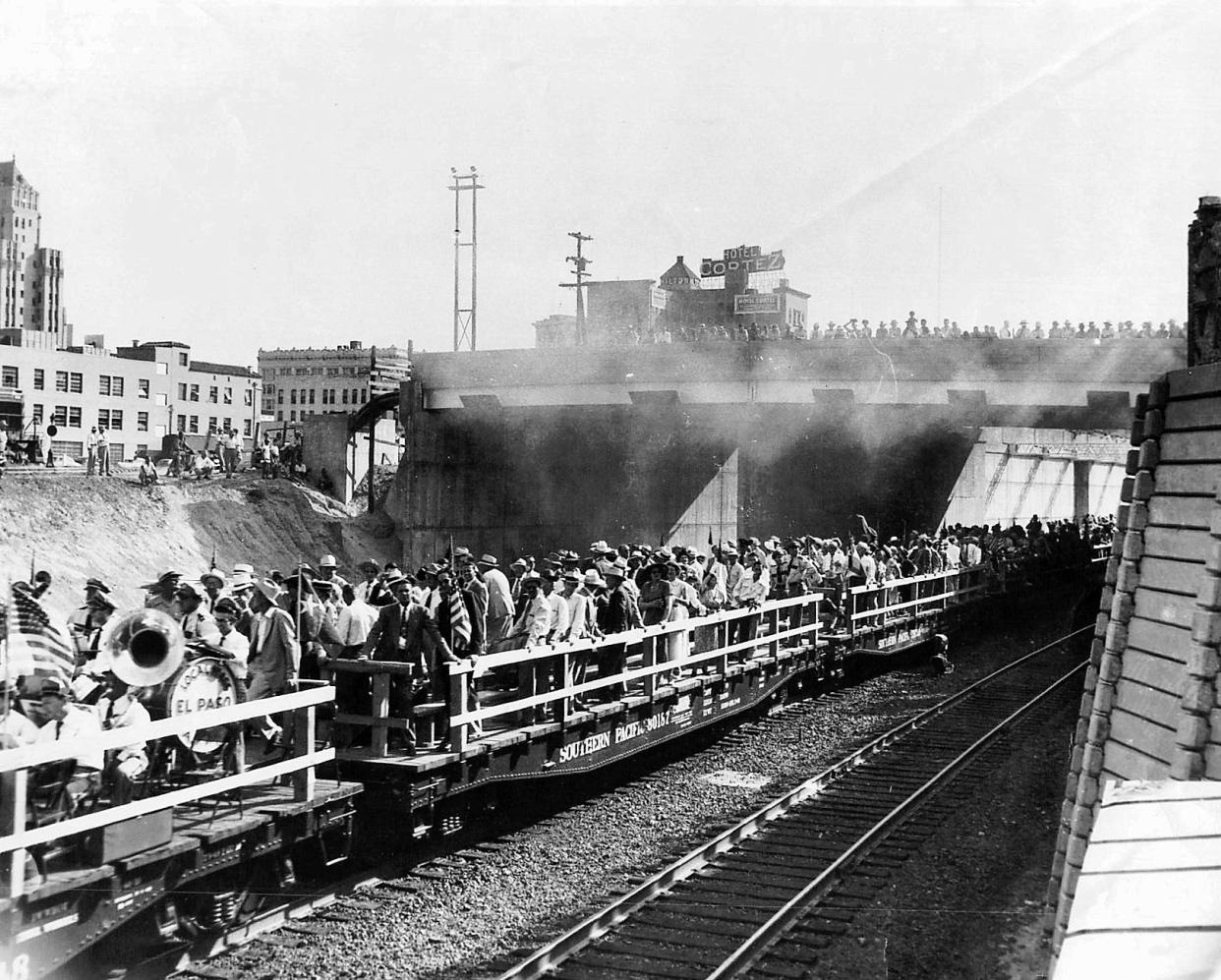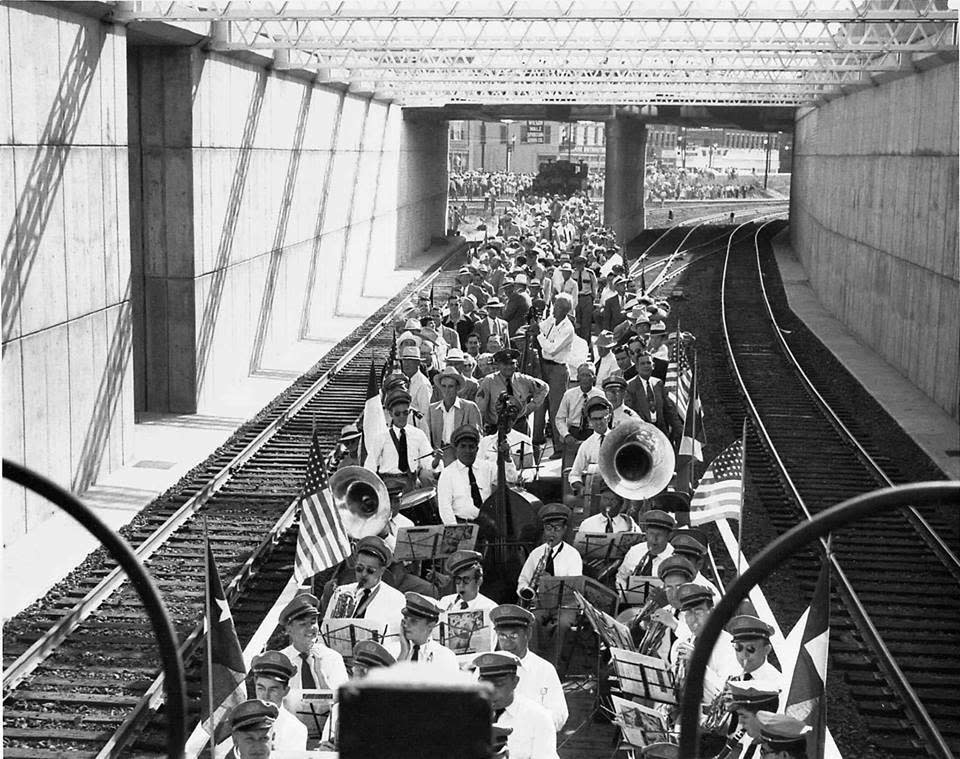Underground train tracks solved Downtown problem, but not without decades of arguments

Trains running through Downtown caused traffic problems almost from the city's beginning. The problem was finally solved with the construction of the submerged track called the Bataan Memorial Trainway. This article from the Aug. 21, 1955, El Paso Times commemorated the five-year anniversary of the opening of the trainway:
New era heralded
Completion of the $5.5 million trainway came after El Pasoans voted a bond issue for its construction on Jan. 4, 1947.
Southern Pacific's Sunset Limited was the first regular train to roll through the track depression, heralding a new era, and making the end of bitter complaints which started eight years after the railroad arrived in El Paso.
A "great red letter day in the history of El Paso" was what Judge R.E. Thomason termed the opening of the tracks as he spoke at the opening ceremony. He said it "marks a milestone in the progress of a growing young city."
R.E. McKee, contractor for the trainway, called it "the climax of much blood, sweat and tears, a project that was not possible without the loss of several lives."
A.T. Mercier, president of the (Southern Pacific) lines, spoke after the band struck up "Casey Jones."
More: FBI looking for leads in 1979 cold case murder of Margaret Mary Hart
Times have changed
"El Paso is the hub of eight railroad lines," he said. "When the railroads first came, there was plenty of room here on the mesa between the mountains and the Rio Grande. Times have changed."
Citizens had complained bitterly that the city's pioneer leaders didn't have foresight to build the tracks elsewhere.
But back in 1881, when the railroad came to El Paso, the tracks were at the edge of the small, dusty village.
It was eight short years after the railroads came to the Pass of the North that The El Paso Times started advocating a solution to the downtown grade crossing problems.
Danger to life and property
On March 10, 1889, the following appeared in a column known as "People and Things."
Almost daily instance of danger to life and property from approaching engines on the Southern Pacific road at our street crossings suggest the necessity of placing guards there to give warning when needed. The building on each side of the road obstructs the view until it is too late, while the rattling of a vehicle often renders the ring of a bell unheard by its occupants. And should it be heard, one cannot always decide whether it is coming or going.
In 1917, the city had a chance to get the trainway done — for free.
In that year, the late Tom Lea, then mayor of El Paso, negotiated a contract with the railroad (to lower the tracks). They agreed to bear the complete cost of the project.
These facts were brought out in 1937 when Mayor M.A. Harlan was attempting to solve the grade crossing. That was the year the City Council passed an ordinance banning downtown grade crossings and ordered the railroads to begin eliminating them within 60 days, but the action failed to produce results.
More: Cannon blast blows UTEP student 30 feet downhill, ends football tradition: Trish Long
Cured of politics
On Aug. 27, 1937, a story in The Times quoted Lea as saying the project was defeated because voters did not want the intersection of Durango and Main streets closed.
Lea has been quoted as saying "defeat of that deal was one of the tragedies of life. That cured me of politics."
Talk of how the smoke from trains would be concentrated in the subway arose, and it seemed to some that the railroads should acquire land and build around the city.
The roads were opposed to rerouting the tracks along the river, with the Chamizal Zone presenting the most serious obstacle.
The Times again took the matter into editorial consideration:
"There is just one issue before the people: Whether we prefer to have the tracks used by the Southern Pacific and El Paso Southwestern and Texas and Pacific Railroads placed in a subway where they no longer will interfere with street traffic, or whether we desire that they shall remain in their present position for another generation or more."
May 16, 1935, The Times noted "revival of a movement to obtain construction of a railroad underpass in downtown El Paso as a part of the federal program to eliminate dangerous traffic hazards and create work for unemployed will be sought."

Updated reports, new plan
This began to get done in 1945, with the close of the war. Pushing the project was Mayor J.E. Anderson, who conferred with railway officials in June 1945. It was decided to conduct a survey and bring all existing reports up to date into one comprehensive plan.
In November 1945, the railroads offered to remove tracks on Main Street west of Stanton Street, run all trains on the old El Paso and Southwestern tracks, and to construct underpasses at Santa Fe and Campbell streets.
The plan was rejected by the council as "wholly inadequate."
A headline on May 31, 1946, read "Trains delay Campbell Street Traffic One Hour, 21 Minutes."
In December, 1946, the formal plan was drawn up by the City and a bond election held on Jan. 4, 1947. The issue passed 3,707 to 345.
Jerry Gerlach, local photographer, later was singled out by the Citizens Track Depression Committee for a big share of the credit for ending the grade crossing nuisance.
The Times featured a Page One spread of pictures, the day the bond issue was voted on, showing El Pasoans lined up for blocks waiting for a freight train, carrying Gerlach snapping pictures, to pass.
More: El Paso area in midst of record-setting warehouse and distribution construction boom
Fractured shoulder, smashed camera
It was Gerlach's pictures in The Times — which cost him a fractured shoulder and a smashed camera — members of the track depression committee said, that helped in a big way to shape up public opinion in favor of the bond issue.
With the bond issue passed, actual work got underway Aug. 21, 1948.
Two years later, the trainway was completed.
On March 10, 1950, City Council authorized Mayor Duke to negotiate with the railroads to name the depression project "Bataan Memorial Trainway" in honor of the World War II dead. Request for tribute was made by Capt. O.E. Saalman, representative of the American Ex-Prison of War Association.
Trish Long may be reached at tlong@elpasotimes.com.
This article originally appeared on El Paso Times: The great trainway debate: Underground tracks solved Downtown problem

